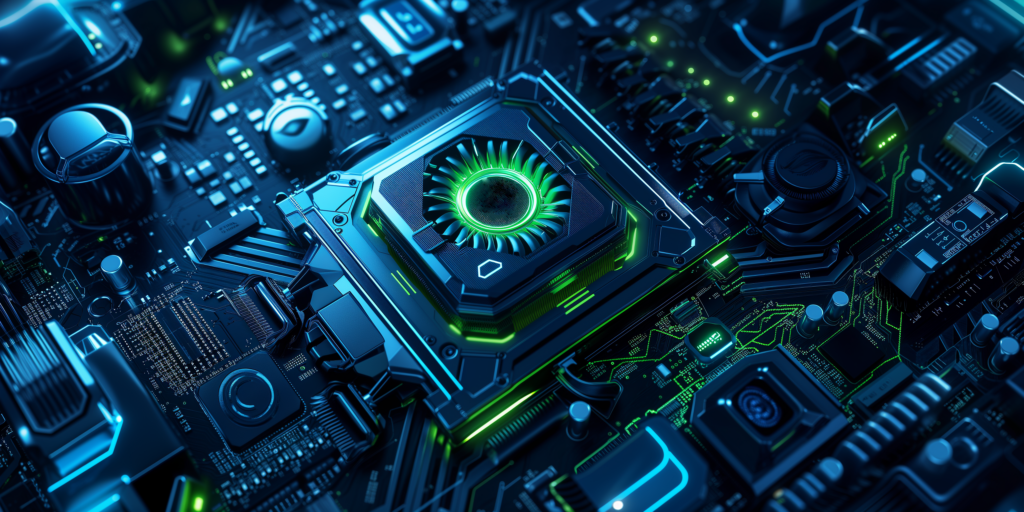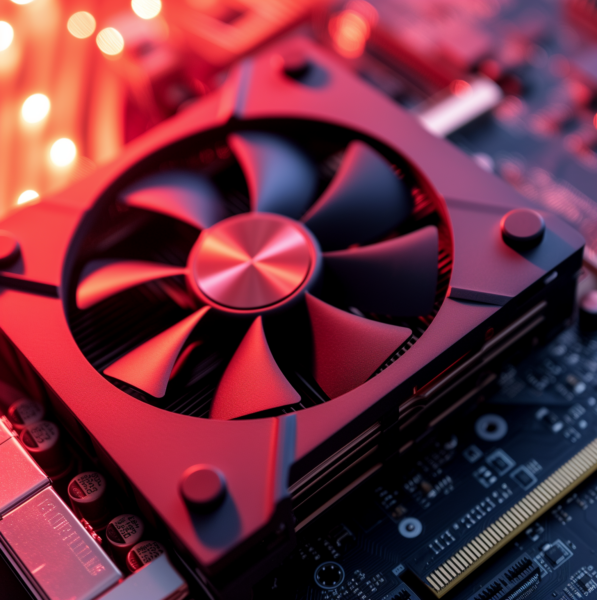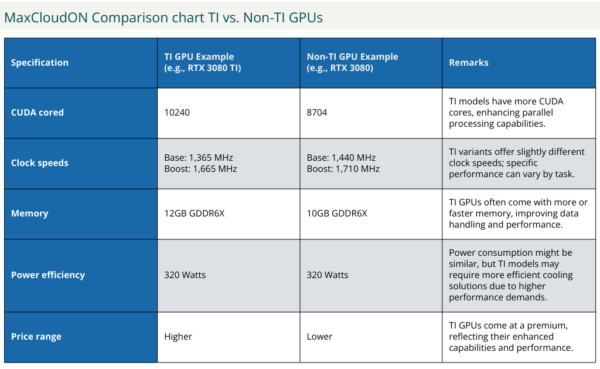
When discussing GPUs (Graphics Processing Units), you’ll often come across the term TI, but solely in the context of Nvidia GPUs. This label, abbreviated for Titanium, is not merely a marketing strategy but a substantial sign of the GPU’s abilities.
This is specially valid in terms of performance improvements over its non-TI counterparts. Understanding the significance of TI in a GPU is crucial for experts in 3D design, animation, architecture, and machine learning. It can significantly impact productivity and project outcomes.
What is TI (Titanium) in Nvidia GPUs
The TI tag in Nvidia graphics cards signifies a model upgraded to offer better performance than the standard version. The TI stands for Titanium, representing strength and high performance in the periodic table.
This naming convention is apt, as TI GPUs aim to deliver excellent performance, making them high-performance graphics cards suited for demanding tasks that require superior processing power.
Nvidia introduced the TI variant to separate their standard and enhanced GPUs. These TI-enhanced models have increased clock speeds, more CUDA cores, and sometimes even additional video memory. All these enhancements contribute to a GPU that can handle more complex calculations, render complex visual effects more smoothly, and maintain optimal performance levels even under heavy loads.
For instance, comparing a standard Nvidia GPU with its TI counterpart, the latter often has more CUDA cores. CUDA cores are parallel processors within the GPU that are crucial for performing complex mathematical calculations required in rendering images, video processing, and GPU servers for different tasks.
TI GPU Benefits
The increased number of CUDA cores in TI GPUs translates to faster processing times and the ability to handle more simultaneous tasks. As a result, it offers a significant advantage for professionals working on complex projects.
TI GPUs frequently boast elevated clock speeds compared to non-TI counterparts. Clock speed, quantified in megahertz (MHz), signifies how swiftly the GPU can execute instructions. Higher than factory-set clock speeds mean a GPU can work faster.
This way, games run smoother with more frames per second, rendering times are faster, and data processing in machine-learning applications is improved. TI is especially helpful if you depend on rapid and efficient processing to meet project timelines and deliver expected results.
TI GPUs also arrive with the assurance of superior performance. This is a benefit not limited to gaming but also includes professional applications like 3D architectural rendering, and machine learning tasks.
For instance, architects and 3D designers can profit from the extra CUDA cores and enhanced clock speeds for swifter rendering of complex scenes. Also, machine learning experts can utilize the additional processing power for quicker algorithm computation and data analysis.
It’s also worth mentioning that Nvidia’s strategy for TI GPUs is not just about shear strength. These GPUs are also crafted with effectiveness in mind, showcasing advanced cooling systems and optimized energy usage.
Such design ensures that the GPUs, even under intense workloads, can sustain prime performance levels without overheating or consuming excessive energy. This aspect is crucial for professionals operating challenging applications for prolonged durations.
The TI designation in Nvidia GPUs signifies a substantial upgrade over non-TI models, providing professionals in diverse fields the additional performance and efficiency necessary to handle their most demanding projects.
Does TI GPUs Increase Performance?
Nvidia TI variants are associated with better performance than their standard counterparts.
Below, we will explore the technical aspects leading to this top-tier performance, providing a clearer understanding of why TI GPUs are often the preferred choice for professionals.
Understanding the Role of CUDA Cores and Clock Speeds in TI GPUs
TI GPUs perform better mainly because of two essential components: CUDA cores and clock speeds. CUDA cores (Compute Unified Device Architecture cores) are parts of Nvidia GPUs. They are parallel processors that perform the complex calculations required for rendering graphics, processing video, and running machine-learning algorithms.
The more CUDA cores a GPU contains, the more calculations it can perform simultaneously, resulting in improved performance in tasks that require intense computation.
TI GPUs are well known for having more CUDA cores compared to their non-TI counterparts. This boost in CUDA cores allows for more effective parallel processing of data, which is especially advantageous for applications such as 3D rendering that simultaneously compute multiple pixels and vertices. For professionals in areas like 3D design and animation, this means decreased rendering times, allowing them to refine their designs more swiftly and effectively.

Higher clock speeds also contribute to the TI GPUs’ performance. Clock speed measures the speed at which a GPU can execute instructions and directly influences the overall data processing speed. TI GPUs, frequently equipped with increased clock speeds, process instructions quicker than their non-TI counterparts.
As a result, they perform smoothly in real-time applications, such as interactive 3D modeling and simulation, where rapid response times are essential.
In machine learning, TI GPUs with more CUDA cores and higher clock speeds can quickly process the computation of complex algorithms and more effective data analysis. Such capabilities significantly speed up the development and training of machine learning models, leading to faster insights and progress in research and development projects.
The increased number of CUDA cores and higher clock speeds contribute to the superior performance of TI GPUs. These upgrades allow professionals across various areas to attain better results in less time, whether working on rendering high-quality 3D visuals, processing vast datasets for machine learning, or running scientific simulations.
Do You Need a TI Graphics Card?
Choosing the best graphics card is very important for those in 3D design, animation, architecture, and machine learning. Deciding to get a TI (Titanium) GPU or a non-TI one is not only about how much it costs.
It’s also about picking the hardware that fits your project’s needs and how well you expect it to perform. In this context, you better understand the added value of TI GPUs, with their enhanced clock speeds and extra CUDA cores.
Evaluating Your Computing Needs: When a TI GPU Makes Sense
TI GPUs, known for their exceptional performance and superior processing capabilities, can handle demanding tasks that require high-performance graphics cards. These tasks include rendering complex 3D scenes, running scientific simulations, and processing large datasets for machine-learning applications.
Machine learning and deep learning developers benefit significantly from the enhanced performance of TI GPUs. The complex calculations involved in training machine learning models demand a high computational power, which TI GPUs can provide thanks to their more CUDA cores and increased clock speeds. This results in faster model training times and more efficient data processing, enabling developers to iterate on their models more quickly and achieve better results.
Likewise, 3D artists and architects depend on GPUs to produce detailed visualizations and complex visual effects. The superior performance of TI GPUs, powered by their higher clock speeds and extra CUDA cores, allows for smoother gameplay and real-time ray tracing, which are crucial for creating immersive visual experiences. The capacity to sustain optimal performance levels under heavy loads guarantees that professionals can finish their projects effectively without compromising quality.
The cost-benefit of investing in a TI GPU must be evaluated. While TI graphic cards provide superior performance and extra performance advantages, they also come at a higher price than non-TI GPUs.
Professionals should balance the additional performance against the higher cost to decide if a TI GPU is a valuable investment for their specific requirements. For tasks that require first-rate performance, the increased cost of a TI GPU might make sense because of the significant enhancements in efficiency and productivity.
The decision between a TI version and a non-TI GPU may also depend on factors like energy consumption and the desire for fluid gameplay or improved abilities in real-time ray tracing. TI GPUs deliver extraordinary performance while optimizing energy usage, making them a responsible choice for extended projects. The enhanced performance and extra CUDA cores of TI GPUs can boost the capacity to manage complex visual effects and challenging computational tasks, offering an advantage for experts working on innovative projects.
Whether you need a TI GPU depends on carefully considering your project requirements, performance expectations, and budget constraints.
Let’s see where TU GPUs can bring significant advantages:
- In machine learning;
- In deep learning;
- In 3D rendering
- When dealing with computationally intensive tasks;
However, it’s important to carefully compare costs and benefits to ensure that investing in a TI GPU matches your professional goals and gives you the expected value.
TI Graphics Cards vs. Non-TI: Pros and Cons
When choosing between TI and non-TI GPUs, professionals must weigh the pros and cons to determine which option best suits their needs. TI GPUs, known for their enhanced performance capabilities, offer significant advantages for demanding tasks.
These benefits come at a cost, financially and in terms of power consumption.

Performance Comparison: TI vs. Non-TI GPUs
TI GPUs are designed to deliver top-tier performance, thanks to their increased clock speeds and additional CUDA cores. These enhancements allow for smoother gameplay, real-time ray tracing, and more efficient processing of complex visual effects and calculations.
On the other hand, non-TI GPUs, though capable, might lag in demanding tasks, resulting in longer rendering times and potentially less detailed outcomes.
Performance vs. Price: Is the Extra Performance Worth It?
The superior performance of TI GPUs comes at a higher price than their non-TI variants. Experts should evaluate whether the enhanced performance justifies the higher expense.
Buying a TI GPU could be worth it for tasks that need top performance, like machine learning, deep learning, and high-end cloud rendering. However, a non-TI GPU may provide a more cost-effective choice for less demanding tasks without performance compromise.
What is the Best TI GPU You Can Buy?
If a TI GPU fits your needs, the next step is to choose the appropriate TI model.
The best TI GPU for you will depend on your specific requirements, including the type of projects you work on, your budget, and your performance expectations.
Top Picks for Different Professional Needs
For machine learning and deep learning, developers need a TI GPU with many CUDA cores and advanced processing power to process complex calculations and data analysis efficiently.
3D artists and architects may prioritize GPUs with higher clock speeds and advanced features like real-time ray tracing to achieve the highest quality visualizations. Ultimately, the best TI GPU is the one that offers the right balance of performance, features, and cost for your specific professional needs.
Conclusion
We explored what makes TI (Titanium) GPUs special, focusing on their enhanced performance capabilities. These features speed up processing times and ensure the ability to handle more complex and simultaneous tasks, thus significantly boosting your productivity and the quality of outcomes in demanding projects.
With technological progress, the appropriate GPU is more important than ever. Choosing a TI GPU allows you to meet your current demands. Also, it prepares you for success in the future of computational innovation and efficiency.
Sources:
Frequently Asked Questions:
-
How do TI GPUs maintain optimal performance levels?
TI GPUs maintain optimal performance through advanced cooling technologies and efficient power consumption, ensuring they can handle demanding tasks without overheating.
-
Can TI GPUs enhance machine learning and deep learning projects?
TI GPUs’ additional CUDA cores and increased clock speeds make them ideal for the complex calculations required in machine learning and deep learning projects, leading to faster processing and more efficient data analysis.
-
Are TI GPUs suitable for gaming and creative work?
TI GPUs are highly versatile, offering benefits for gaming and creative work. Their ability to handle complex visual effects and maintain high-performance levels makes them suitable for various applications, from high-end gaming to professional 3D rendering and real-time ray tracing.
